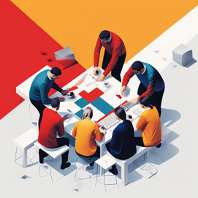In all the Lean methodologies, Kanban stands out as a powerful tool for optimizing the flow of work...
The Main Pillars of Lean

Lean Management is a philosophy that aims to deliver maximum value to customers while minimising waste.
It's a comprehensive approach that involves every level of an organization, from the CEO to the front-line workers. Here are the main pillars of Lean management.
Respect for People
At the heart of Lean Management is respect for people. This principle recognizes that lower-level employees, who are closest to the customer and do most of the work, are vital to the organization's success. Encouraging feedback, listening to their opinions, and responding promptly are all critical for this principle. It's about fully leveraging employees' talents and fostering an environment where knowledge is shared freely.
This respect for people can be seen in the inverted pyramid management system, where leaders serve employees, enabling them to serve customers better.
Just in Time (JIT)
JIT is a production strategy that strives to improve a business's return on investment by reducing in-process inventory and associated carrying costs. It's about increasing 'flow' – how work progresses through a system – without building unnecessary blockers and frictions. Tools like Kanban can improve flow and manage work more efficiently.
The Seven Forms of Waste
Lean Management identifies seven forms of waste:
- overproduction
- waiting
- transporting,
- inappropriate processing
- unnecessary inventory
- unnecessary motion
- defects.
By identifying and eliminating these wastes, your company can improve efficiency and productivity. But it's not just about physical waste. Consider also the waste in management and decision-making, such as delays, redundancies, or miscommunication.
The Scientific Method
Lean Management encourages facts, data, processes, and measurements instead of opinions or assumptions. Tools like the 5 Whys or Fishbone diagrams can be used to diagnose problems and identify their root causes. This approach promotes problem-solving based on evidence and continuous learning.
Go and See
This principle emphasises the importance of firsthand experience. If there's a problem, don't make assumptions - go and see where it happens. This direct observation allows for a deeper understanding of the processes and problems, leading to more effective solutions.
Levelling
Levelling is about balancing the workload to reduce stress on the business and improve efficiency. It's traditionally used in manufacturing, but the concept also applies to other business environments. For example, In asset creation and sign-off, levelling can help manage workloads and prevent bottlenecks.
Visual Display
Visual displays are used to communicate goals and progress. They can range from simple charts to complex dashboards. These visual tools help ensure everyone understands the target state and can quickly identify when targets are not being met.
Kaizen
Kaizen, or continuous improvement, is a core principle of Lean Management. It's about making small, incremental changes that add to significant improvements over time. It's an ongoing effort to improve products, services, or processes.
Lean Management is more than a set of tools or techniques. It's a philosophy that requires a shift in mindset at all levels of the organization. By understanding and implementing these principles, organizations can deliver more value to their customers, improve their processes, and create a more engaging and productive work environment.



